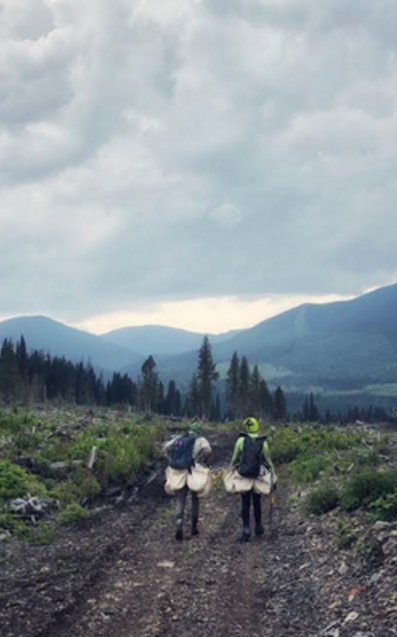Seagrass Planting: A Bid To Revitalize Scotland's Coastal Ecosystem

Table of Contents
The Ecological Importance of Seagrass in Scotland
Seagrass meadows are far more than just pretty underwater plants; they are dynamic ecosystems teeming with life and providing crucial services to the wider environment.
Biodiversity Hotspot
Seagrass beds act as vital nurseries and habitats for a diverse array of marine species. They provide food and shelter for countless organisms, supporting commercially important fisheries.
- Key Species: Scottish seagrass meadows support populations of cod, plaice, seahorses, crabs, lobsters, and numerous other invertebrates. These species are crucial to the health of the wider marine ecosystem and provide significant economic value through fishing industries.
- Nursery Function: Young fish and invertebrates utilize the dense seagrass leaves for protection from predators, allowing them to thrive and contribute to the overall health of the fish stocks. This "nursery" role is critical for maintaining biodiversity and supporting healthy populations.
- Biodiversity Keystone: The high biodiversity within seagrass meadows underscores their importance as a keystone habitat. The loss of seagrass directly impacts the entire food web, reducing the overall health and resilience of the coastal ecosystem.
Carbon Sequestration and Climate Change
Seagrass plays a remarkable role in mitigating climate change through its exceptional carbon sequestration capabilities. Known as "blue carbon," this process is significantly more efficient than that of terrestrial forests.
- Blue Carbon Powerhouse: Seagrass meadows can sequester carbon at a rate up to 35 times faster than tropical rainforests, making them incredibly effective carbon sinks. This carbon is stored in the sediment, preventing its release into the atmosphere.
- Long-Term Storage: The organic carbon trapped within seagrass sediments can remain stored for millennia, offering a long-term solution for carbon removal and climate change mitigation. Seagrass restoration therefore offers a powerful, natural tool in tackling climate change.
- Protecting Our Planet: Restoring and protecting seagrass meadows is crucial for achieving global climate goals and safeguarding the future of Scotland’s coastlines.
Coastal Protection
Seagrass beds act as natural barriers, protecting coastlines from erosion and storm damage. Their intricate root systems stabilize sediments and reduce wave energy.
- Natural Coastal Defense: Seagrass significantly reduces the impact of waves, acting as a buffer against coastal erosion. This natural protection saves money on costly coastal defenses and prevents the loss of valuable land.
- Storm Protection: The dense growth of seagrass dissipates wave energy, minimizing the damage caused by storms and protecting vulnerable coastal communities.
- Economic Benefits: The protection provided by seagrass translates into significant economic benefits by reducing the need for expensive human-made coastal defenses and preventing damage to coastal properties and infrastructure. Examples of such areas benefiting from seagrass protection include the Firth of Forth and the Moray Firth.
Seagrass Planting Techniques and Challenges in Scotland
Successfully restoring Scotland's seagrass meadows requires careful planning and execution, utilizing appropriate techniques while addressing various environmental and logistical challenges.
Methods of Seagrass Restoration
Several methods are employed for seagrass planting, each with its advantages and disadvantages.
- Seed Dispersal: This technique involves collecting and sowing seagrass seeds directly into suitable habitats. While cost-effective, it can be challenging to achieve high germination rates.
- Transplanting: This involves transplanting shoots or plugs of existing seagrass into new areas. While more labor-intensive, it offers higher success rates compared to seed dispersal.
- Vegetative Propagation: This approach involves using vegetative fragments (rhizomes) to propagate seagrass, offering a rapid expansion of the seagrass meadow. This method requires careful selection of plant material to ensure genetic diversity and health. Innovative approaches using drone-assisted planting are increasingly being explored.
Environmental Considerations
Seagrass restoration faces many hurdles, including careful site selection, maintaining water quality, and mitigating human impacts.
- Site Selection: Choosing appropriate sites considering water depth, light penetration, sediment type, and water quality is critical.
- Water Quality: Pollution from agricultural runoff, sewage, and industrial discharge can significantly hamper seagrass growth. Improving water quality is essential for successful restoration.
- Human Impacts: Boat anchors, dredging, and coastal development continue to threaten seagrass habitats. Addressing these impacts and implementing protective measures is crucial. Community involvement in monitoring and reporting human impacts is key for project success.
Funding and Support
Seagrass restoration in Scotland relies on a combination of public and private funding and community engagement.
- Government Grants: Various government agencies and environmental trusts provide funding for seagrass restoration projects, recognizing their ecological and economic value.
- Private Donations: Private companies and philanthropic organizations play a crucial role in supporting seagrass restoration initiatives.
- Community Involvement: Community-led projects are instrumental in planting and monitoring seagrass meadows, fostering a sense of ownership and stewardship. Organizations like Seawilding and the Scottish Wildlife Trust play a key role in coordinating and supporting these efforts.
The Future of Seagrass Restoration in Scotland
Sustaining the momentum of seagrass restoration requires ongoing monitoring, research, supportive policies, and continued community engagement.
Long-Term Monitoring and Research
Continuous monitoring is critical for evaluating the success of planting efforts and informing future restoration strategies.
- Technological Advancements: Remote sensing technologies, such as satellite imagery and drones, provide efficient and cost-effective methods for monitoring seagrass growth and health.
- Ongoing Research: Research continues to investigate the best planting techniques, suitable site selection criteria, and the long-term impacts of seagrass restoration.
Policy and Legislation
Stronger policies and legislation are crucial to protecting existing seagrass meadows and supporting restoration efforts.
- Marine Protected Areas: Expanding the network of Marine Protected Areas to include seagrass habitats is essential for their long-term protection.
- Legislation: Existing legislation aimed at protecting coastal habitats needs to be strengthened and enforced effectively. This includes regulations aimed at reducing pollution and minimizing the impact of human activities.
Community Engagement
Community involvement is fundamental to the long-term success of seagrass restoration projects.
- Citizen Science: Engaging local communities in monitoring and restoration efforts fosters a sense of ownership and stewardship, ensuring long-term success.
- Educational Programs: Raising public awareness through educational programs and outreach initiatives is critical for promoting support and encouraging responsible behavior.
Conclusion:
Seagrass planting is paramount for the restoration of Scotland's coastal ecosystems. These underwater meadows offer unparalleled ecological benefits, from supporting rich biodiversity to mitigating climate change and protecting coastlines. While challenges exist, innovative techniques, funding opportunities, and strong community engagement are paving the way for a healthier future for Scotland’s seas. We must all contribute to this vital work. Learn more about seagrass restoration initiatives in Scotland by visiting [link to relevant organization 1] and [link to relevant organization 2], and consider volunteering your time to support these crucial efforts. The future health of Scotland's coastline depends on our collective commitment to seagrass planting and the preservation of these vital ecosystems.

Featured Posts
-
 Gigi Hadid Bradley Cooper And Leonardo Di Caprio Avoiding Ex Drama
May 04, 2025
Gigi Hadid Bradley Cooper And Leonardo Di Caprio Avoiding Ex Drama
May 04, 2025 -
 Canelo Alvarezs Concise Opinion Jake Paul And Beyond
May 04, 2025
Canelo Alvarezs Concise Opinion Jake Paul And Beyond
May 04, 2025 -
 Colonial Downs Virginia Derby Date And Details Announced By Stone
May 04, 2025
Colonial Downs Virginia Derby Date And Details Announced By Stone
May 04, 2025 -
 Sydney Sweeneys Sparkling Pink Barbiecore Gown At The Vanity Fair Oscars After Party
May 04, 2025
Sydney Sweeneys Sparkling Pink Barbiecore Gown At The Vanity Fair Oscars After Party
May 04, 2025 -
 Oscars 2024 Addressing The Feud Rumors Between Emma Stone And Margaret Qualley
May 04, 2025
Oscars 2024 Addressing The Feud Rumors Between Emma Stone And Margaret Qualley
May 04, 2025
